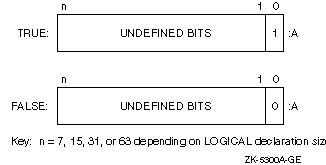Logical data can be 1, 2, 4, or 8 bytes in length.
The default data size used for a LOGICAL data declaration is LOGICAL(4) (same as LOGICAL(KIND=4)). However, you can specify a compiler option to override the default. Option integer-size 16 can be used to specify LOGICAL(2) and option integer-size 64 can be used to specify LOGICAL(8).
To improve performance on systems using Intel® 64 architecture, use LOGICAL(4) (or LOGICAL(8)) rather than LOGICAL(2) or LOGICAL(1). On systems using IA-32 architecture, use LOGICAL(4) rather than LOGICAL(8), LOGICAL(2), or LOGICAL(1).
LOGICAL(KIND=1) values are stored in 1 byte. In addition to having logical values .TRUE. and .FALSE., LOGICAL(1) data can also have values in the range -128 to 127. Logical variables can also be interpreted as integer data.
In addition to LOGICAL(1), logical values can also be stored in 2 (LOGICAL(2)), 4 (LOGICAL(4)), or 8 (LOGICAL(8)) contiguous bytes, starting on an arbitrary byte boundary.
If the fpscomp nological compiler option is set (the default), the low-order bit determines whether the logical value is true or false. Specify fpscomp logical instead of fpscomp nological to interoperate with procedures written in C for Microsoft* Fortran PowerStation logical values, where 0 (zero) is false and non-zero values are true.
LOGICAL(1), LOGICAL(2), LOGICAL(4), and LOGICAL(8) data representations (when fpscomp nological is set) appear below.
